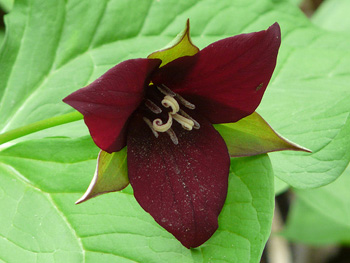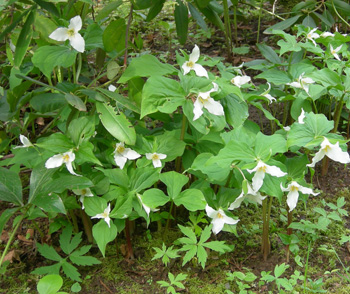Contents:
Common Names | Parts Usually Used | Plant(s) & Culture | Where Found | Medicinal Properties | Biochemical Information
Legends, Myths and Stories | Uses | Formulas or Dosages | How Sold | Bibliography
Scientific Names

- Trillium pendulum L.
- Trillium erectum. L.
- Liliaceae
- Lily family
Common Names
- American ground lily
- Beth root
- Coughroot
- Ground lily
- Indian balm
- Indian shamrock
- Jew’s-harp plant
- Lamb’s quarter (Chenopodium album)
- Milk ipecac
- Nodding wakerobin
- Pariswort
- Rattlesnake root
- Red trillium
- Snakebite
- Three-leaved nightshade
- Trillium
- Wake-robin
Parts Usually Used
Rootstock (dried rhizome)
Back to Top
Description of Plant(s) and Culture

Birthroot is an herbaceous perennial plant; grows to the height of
Back to Top
Where Found
Found in rich soils and shady woods of the central and western states. Nova Scotia to Georgia mountains, Florida; Tennessee to Michigan, Ontario.
Back to Top
Medicinal Properties
Antiseptic, astringent, diaphoretic, emmenagogue, expectorant, tonic, alterative, pectoral
Back to Top
Biochemical Information
Tannin, resin, glycosides trillin and trillarin, traces of essential oil, saponin, fatty oil and starch
Back to Top
Legends, Myths and Stories
The root has the faint fragrance of turpentine and a peculiar aromatic and sweetish astringent taste when first chewed, but becomes bitter and acid, causing salivation. Its shape is remindful of popular Ginseng root.
Back to Top
Uses
Birthroot can be used for coughs, bronchial problems, hemorrhage from the lungs, asthma, difficult breathing, pulmonary consumption, and boiled in milk for diarrhea and dysentery. Used externally and internally for female problems. A poultice or salve relieves insect bites and stings, tumors, inflammations, and ulcers, snakebites, wounds, skin irritation. Birthroot is an indication of its use by the Native Americans as an aid during childbirth. They also used birthroot for menopause, aphrodisiac (root contains steroids). A tea of equal parts of Bugleweed (Lycopus virginicus) and birthroot was once used for diabetes.
Back to Top
Formulas or Dosages
Decoction: use
Tincture: take
Back to Top
How Sold
Available in whole, cut, or powdered form as well as capsules. Tincture
Back to Top
Bibliography
![]() Back to Eden
Back to Eden, by Jethro Kloss; Back to Eden Publishing Co., Loma Linda, CA 92354, Original copyright 1939, revised edition 1994
![]() The Herb Book
The Herb Book, by John Lust, Bantam Books, 666 Fifth Avenue, New York, NY. copyright 1974.
![]() Eastern/Central Medicinal Plants
Eastern/Central Medicinal Plants, by Steven Foster and James A. Duke., Houghton Mifflin Company, 215 Park Avenue South, New York, NY 10000
![]() Planetary Herbology
Planetary Herbology, by Michael Tierra, C.A., N.D., O.M.D., Lotus Press, PO Box 325, Twin Lakes. WI 53181., Copyright 1988, published 1992
![]() Indian Herbalogy of North America
Indian Herbalogy of North America, by Alma R. Hutchens, Shambala Publications, Inc., Horticultural Hall, 300 Massachusetts Avenue, Boston, Massachusetts 02115, 1973
![]() American Folk Medicine
American Folk Medicine, by Clarence Meyer, Meyerbooks, publisher, PO Box 427, Glenwood, Illinois 60425, 1973
![]() Webster’s New World Dictionary
Webster’s New World Dictionary, Third College Edition, Victoria Neufeldt, Editor in Chief, New World Dictionaries: A Division of Simon & Schuster, Inc., 15 Columbus Circle, New York, NY 10023
 An Instant Guide to Medicinal Plants
An Instant Guide to Medicinal Plants, by Pamela Forey and Ruth Lindsay, Crescent Books (January 27, 1992).
 The Rodale Herb Book: How to Use, Grow, and Buy Nature’s Miracle Plants (An Organic gardening and farming book)
The Rodale Herb Book: How to Use, Grow, and Buy Nature’s Miracle Plants (An Organic gardening and farming book), edited by William H. Hylton, Rodale Press, Inc. Emmaus, PA, 18049., 1974
